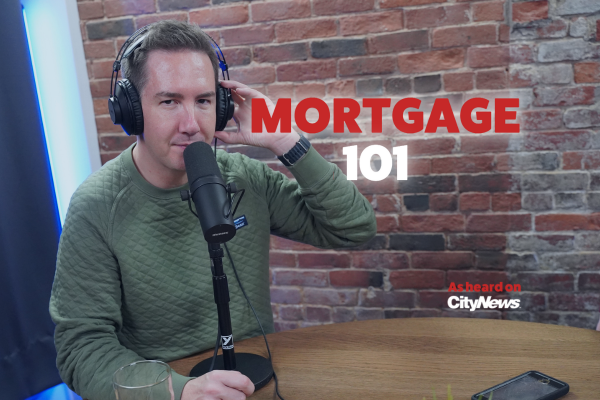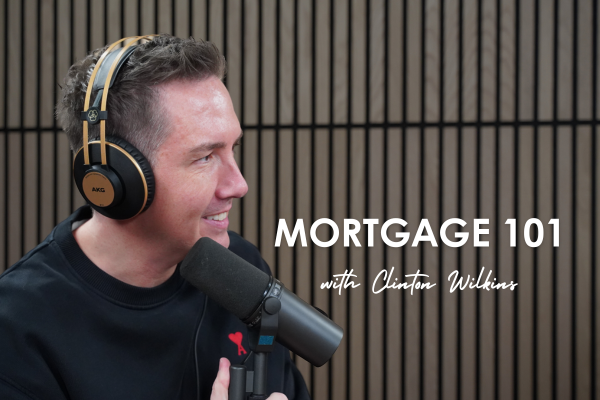Todd Veinotte and Clinton Wilkins discuss the evolving landscape of mortgage lending, highlighting its complexities and the importance of staying informed.

Mortgage 101 – The Influence of Income | November 9th, 2023
How does your income impact your mortgage options? In this instalment of Mortgage 101, Clinton Wilkins and Todd Veinotte dive into the intricate relationship between different income types and their impact on securing a mortgage. They also talk about the various kinds of self-employment and make some predictions for interest rates in 2024.
Interest rate predictions for 2024
Clinton Wilkins 00:00
We’re in Toronto, we had our mortgage professionals Canada conference just a couple of weeks ago. And fun fact, Benjamin Tal, the chief economist for the Canadian Imperial Bank of Commerce, CIBC he spoke. And he says that he thinks that the Bank of Canada is going to start softening the rates, June, July of 2024. So we’ll see if Benjamin Tal is correct. Let’s just mark our calendars here. It’s November 2023. Let’s see what happens by, let’s go by July 2024. And we’ll see what happens.
Todd Veinotte 00:36
It’s interesting, because on my regular talk show on CityNews 95.7, of course, I had, I have one in particular who’s a strong proponent of raising interest rates as being the really one of the key ways to curb inflation. But then I had Jim Stanford on who’s an economist, and he is more center left. And he suggests that it’s too heavy of a tool, that it’s hurt a lot of people.
Clinton Wilkins 01:01
I think so. And the challenge is with the Bank of Canada, and we’re not going to dive too deep into it, because we’re focusing on financial literacy, but it is a piece of financial literacy. And I think, you know, it’s good for people to understand what’s going on. It takes a long time for an increase that the Bank of Canada does, to actually have an impact on inflation. So it takes 4, 6, 8, 12 months for us to really see the impacts of an increase in the interest rate. So that being said, I think they overreached.
Todd Veinotte 01:32
You’re talking about the Bank of Canada?
Clinton Wilkins 01:33
The Bank of Canada. And we will see what’s coming in the next weeks and months. But I am cautiously optimistic that 2024, by the midway through the year, we’re going to start seeing some softening of the rates. But I think that being said, we will likely be probably in a full fledged, like recession by then.
Todd Veinotte 01:51
Okay. And one of the nice things about it being Financial Literacy Month is that we’re going to have you on for a number of times, including two live shows. For which we will take calls.
Clinton Wilkins 02:00
For sure. So if anybody’s curious, they can listen to us on City News, on November 16th. And November 30th. We’re gonna take calls live on the air. 12 till 1. And we’re actually gonna have a couple of guests on as well. So I think it’s gonna be a really fun show. We’re gonna do it live. Normally, if you’re listening to us Mortgage 101, we pre-record it. It’s on once a month. We still love giving lots of information. But we can’t take calls, just the way that this format works. But we’re going to be doing it November 16th and 30th.
Todd Veinotte 02:27
Because when you look back to when this all started, you and it was all weekend show. It was a live show.
Clinton Wilkins 02:32
It was always a live show. We always love taking calls.
Todd Veinotte 02:35
People love to call.
Clinton Wilkins 02:36
Yeah, they certainly do. So I think we’re gonna get a lot of calls Todd because it’s been a couple years really, since we’ve done that, in that time of format.
The various types of income sources
Todd Veinotte 02:42
Alright so income obviously is a huge component. Look, when it comes to your finances. It starts with the income right, let’s call it what it is.
Clinton Wilkins 02:51
If you don’t have income, you probably have problems.
Todd Veinotte 02:54
Well, you don’t have any, you have no finances.
Clinton Wilkins 02:56
In some cases. Yes. For many cases, there’s always going to be lots of income and Todd, one thing that you wanted me to talk about was, what are the different types of income? There are so many I can probably I’m going to start listing them, and I’m going to miss some. So let this is going to be my rider that I’m going to state all kinds of different types of income, but there’s going to be more. There’s always more. Let me just like loosen up here a little bit.
Todd Veinotte 03:20
Alright, loosen up. I’m gonna do the same thing. Stretch.
Clinton Wilkins 03:22
Yep, so one of the big ones, obviously, if you’re on a salary. Or if you’re an hourly employee –
Todd Veinotte 03:28
Let me ask you this. Sorry to interrupt you, I would assume that salary would be the most common form of income you come across.
Clinton Wilkins 03:33
I would say it’s the most common. Salary or hourly, those are probably the two most common types. If you’re hourly, either you’re full time or you’re part time. If you’re full time, either guaranteed hours or not. Anytime that someone’s hourly we normally ask for a two year average, unless there really is a strong guarantee. So we’d average two years, if someone’s T4s. We typically would get their employer issued T4s, not necessarily the T4s that you download from the CRA website, but the ones that your employer gives you because it has all the good information on there that we need. And we typically would also ask for a pay stub. Okay. Salary or hourly.
Todd Veinotte 04:11
You’re making up words.
Clinton Wilkins 04:13
I know I’m just like, it’s hard to get it out now. I don’t know. So there’s also self employed.
Todd Veinotte 04:18
Yes, that’s got to be one of the more complex things.
Clinton Wilkins 04:21
I would say that is certainly very complex. And we’ll talk about that one at the end. There’s pension income.
Todd Veinotte 04:28
Yes. Which is –
Clinton Wilkins 04:29
Obviously very common as well. So it could be an employer’s pension. It could be CDP. It could be OAS.
Todd Veinotte 04:35
You’d see a lot of that here with a lot.
Clinton Wilkins 04:37
A lot. A lot. There’s also child tax benefit that can be used as income. There is spousal support.
Todd Veinotte 04:45
Let me ask you on the child tax benefit as income though, that would, you would have to be cognizant of the ages of the kids I assume?
Clinton Wilkins 04:51
Typically, the rule of thumb is like the kids need to be 13 years old or less.
Todd Veinotte 04:55
Or less otherwise, otherwise they’ll aged out.
Clinton Wilkins 04:59
They’ll will age out. Yeah, we can also use spousal support.
Todd Veinotte 05:04
And that also could age out.
Clinton Wilkins 05:05
That could age out as well. So we need to see how long is that going to be indefinite? Or is it only for a certain period of time.
Todd Veinotte 05:09
And has it been consistent as well?
Types of self-employment
Clinton Wilkins 05:11
Yeah, so that’s another thing we look at. So we’d either get a court order or a Separation Agreement. But oftentimes, we want the bank statements, to see if you’re actually getting the money. Also child support. That can also be used as income. Again, just like child tax benefit, we want to know what the age of the kids are, and that you’re actually getting the money. You know, and with self employment, we’ll, we’ll kind of circle back here, there’s so many different types. One of the main types of self employment is a sole proprietor. It’s very, very common. You know, you are you just set up a shingle, it could even be under your own name, and you do any type of business, it could be a professional service, you could be mowing lawns, you could be a contractor, and a sole proprietor would be someone that claims all the income basically through, because there’ll be a business account, but through their own name, okay? Then there could be a partnership. So it’s similar to a sole proprietor, but it’s maybe a couple people together. Then there would be a corporation. And from a corporation, you would typically get paid either a T4 so similar to a salary, or hourly, or you’re gonna get a dividend, or you’re gonna get both. Okay, typically, when we have a self-employed individual, and if we’re going to go to a bank lender, we would do a two year average of their income. So it’s a two year average up your sole proprietor income, or a two year average of your T4 income, or a two year average of your dividend income, or combination of that. If you don’t have a consistent combination, so T4 to T4, dividend to dividend, sole proprietor to sole proprietor, we would need an exception. Or fun fact, the Government of Canada wants lenders to be more flexible with people who are self employed. As you know, more and more Canadians are becoming self-employed every day. So let’s say Todd, you are working in the trades. So let’s say that you’re a carpenter. And you’ve worked for a carpenter for, you know, 10 years for a contracting company, and then you go and you become self-employed. lenders typically will allow us to average your previous employment, as long as we can prove that you’re making consistent income in a similar type of level with your self-employment. So maybe you’re only self-employed 6 months, or 12 months or 18 months, and you don’t have a good 2 year average, we can sometimes get an exception, if you’ve been in that same, you know, same trade, same industry, and the income has been consistent previously.
Self-employed individuals benefit financial advice
Todd Veinotte 07:42
Alright, so the most, I guess the the cleanest when you’re going to a lender, when the easiest, or the easiest would be obviously the the salary, or the working for somebody basically,
Clinton Wilkins 07:55
Getting any type of income, or you’re getting deductions at source is typically the easiest. I find the clients that, you know, find us the most rewarding that we’re able to help them the most are the people that are self employed, because I can tell you so many self employed people have either had challenges or have been turned down by a lender and they’re kind of gun shy. They’re like, oh, we don’t like the bank. The banks have done me wrong in the past. And you know, they need that financial advice. But those I find are more interesting. There’s always a story. Yes, there’s more documentation, but oftentimes, we can really help them. You know, I had a borrower recently, and there was a loan that was given out to self-employed people called SEBA. Okay, this was a loan that the government gave out with the banks. We actually did a refinance on his home to pull some equity out to pay down the SEBA loan.
Todd Veinotte 08:43
Nice.
Clinton Wilkins 08:44
So, so happy. That’s just one little tidbit. And we were able to help him.
If you’ve liked what you’ve heard, and you want to learn more, feel free to visit us online at Tim clinton.ca.


